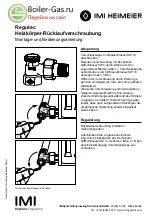
User’s manual
16.2.2.11
Checking DHW flow sensor
Render boiler into DHW mode (see p.
3.2.2
, page 8), open a tap in DHW line. Put the cables off from the DHW
flow sensor 15 (see p.
13.1
, page 24). Boiler should enter into the stand-by mode.
After connecting the cables back, boiler should automatically switch on.
16.2.3
Checking of air pressure in the expansion tank
Demount an expansion tank (see p.
17.5
, page 38), without putting it off from the boiler. Through the valve
(nipple), located in the upper part of the tank, measure air pressure. Pressure should be (0,1
0,02) MPа. If the pressure
in the expansion tank is lower than the allowed one, it is necessary to increase it up to the required value by the pump
or any other safe device. If the inner membrane is damaged (when measuring the air pressure, there is water in the
valve or air pressure doesn’t restore), it is necessary to replace the expansion tank.
16.2.4
Checking of the air inlet and combustion products output systems on leak resistance
Visually check exhaust flue integrity. Sags and gaps in the joints of the exhaust flue elements are not allowed.
Joints of the separate exhaust flues which elements do not consist of presence of O-Rings, should be sealed with
aluminum heat-resistant tape or any other material with similar properties.
16.2.5
Checking of DHW water consumption
Determine maximum water flow in DHW line with a draw down gauge. Water consumption should be at least 2,5
l/min. If water flow is less than 2,5 l/min, it is necessary to clean the boiler’s inlet water filter in DHW line (if filter is
mounted).
16.2.6
Checking of heating system’s with respect to its stoppage
When boiler is operating in CH (see p.
3.2.4
, page 9) it is necessary to check whether a bypass pipe heats. If
bypass pipe is heated constantly, it is necessary to clean a boiler’s inlet water filter in CH line (if filter is mounted),
and also in other heating areas where contamination is possible. Before cleaning a filter, it is necessary to Switch the
boiler off and drain the water out of the boiler (see p.
10.4
and
10.5
, page 21) (if there are no shut off valves, to drain
the water out of all heating systems).
17
BOILER’S DISASSEBMBLING AND DISMANTLING OF MAIN UNITS
Boiler’s disassembling and all dismantling activities of the main units are performed only
when the boiler is off,
electricity power, gas and water supply are off
. For any work concerning dismantling, it is necessary to drain the
water out of the boiler (see p.
10.5
, page 21).
17.1
Burner block dismantling
To disassemble a burner and manifold which are concerned to be the parts of the burner block it is necessary:
1)
Switch the boiler off (see p.
10.4
, page 21);
2)
Unscrew 4 self-threading screws of casing fastening to the boiler’s lowest panel;
3)
Remove the cap of front panel;
4)
Unscrew two self-threading screws 1 and four self-threading screws 2 (see scheme.
13
) of fastening to the
front panel to the casing;
Scheme 13. Casing dismantling to the front panel
5)
Throw a front panel with a cap down;
6)
Put a casing off pulling it up over yourself;
7)
Unscrew 4 self-threading screws sealing cap’s fastening
8)
Put a cap off pulling it hard up over your self. When assembling take into consideration proper installation of
the cap’s sidewalls which should enter slots on the back side of the boiler.
Caution! Ground cables are fixed under left low self-threading screw of the sealing cap’s fastening. When
assembling ground cables, they should be mounted on their places and tightly fixed by the self- threading
screws.
9)
Unscrew 2 self-threading screws 1 (
see scheme 14)
of plate’s fastening with the plugs and put a plate off;














































